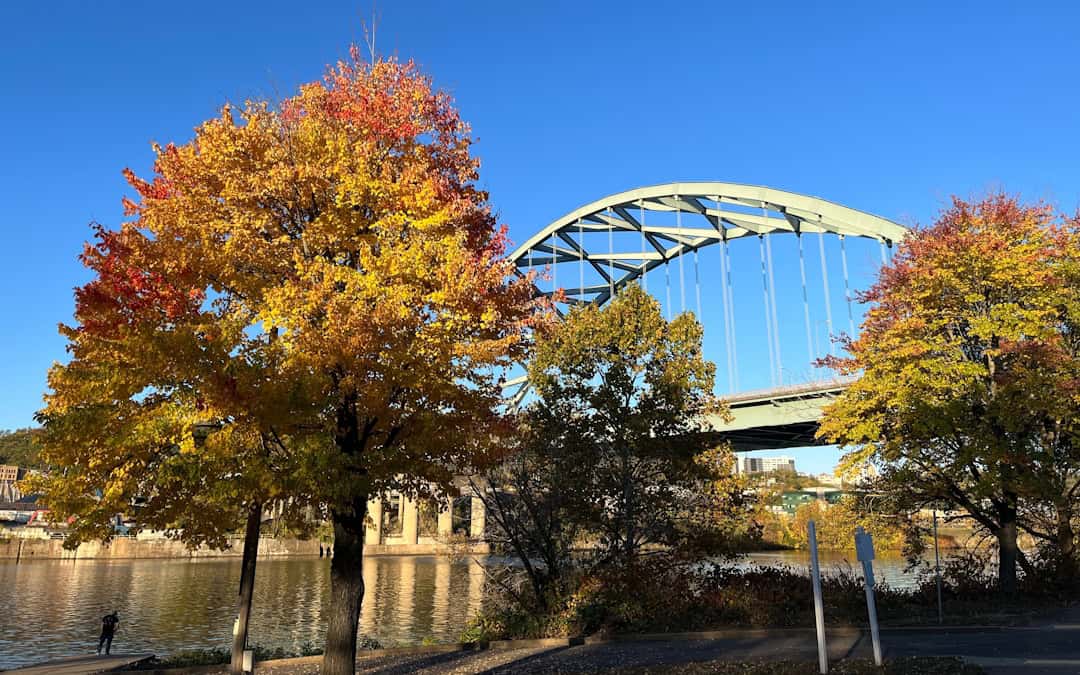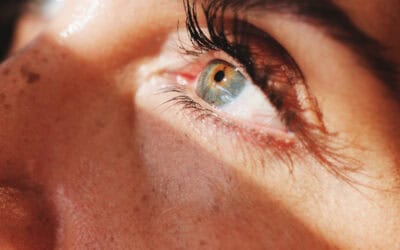Pennsylvania ranks among the worst states in the country for allergies. Your eyes face a particularly tough challenge during Pittsburgh’s fall season, when an estimated 100 million Americans battle seasonal allergies that can make daily life miserable.
Fall creates the perfect storm for allergy sufferers in and around the City of Bridges. Ragweed dominates Pennsylvania’s autumn landscape, releasing pollen particles so tiny they can travel hundreds of miles through the air. The state’s unusually high pollen concentration means Pittsburgh residents often experience weeks of uncomfortable symptoms that can significantly impact their quality of life.
Your eyes deserve protection during this challenging season. Whether you’re already experiencing the telltale signs of itchy, watery eyes or simply want to prepare for what’s coming, understanding your triggers and taking the right protective steps can make all the difference. This guide explains what’s attacking your eyes during Pittsburgh’s fall allergy season and provides proven strategies to keep your vision comfortable when allergens are at their worst.
Understanding Fall Allergies in Pittsburgh
Pittsburgh’s autumn season delivers more than colorful leaves and crisp air. From August through the first hard frost, residents battle a concentrated assault of airborne allergens that create some of the year’s most challenging conditions for eye health.
What triggers allergies in Pennsylvania during fall
Ragweed dominates Pennsylvania’s fall allergy landscape with a vengeance. This aggressive weed blooms from August to November, releasing peak pollen levels during mid-September that can make life miserable for allergy sufferers. The plant’s tiny pollen particles become airborne missiles, traveling hundreds of miles on wind currents to reach unsuspecting eyes far from their source.
Several other weed species join ragweed’s assault on eye comfort:
- Wormwood (mugwort) releases pollen from mid-summer through early fall
- Amaranth (pigweed) produces heavy pollen loads that saturate the air
- Sagebrush creates lightweight pollen easily carried by even gentle breezes
- Orache (saltbush) often combines with pigweed to create particularly intense reactions
Mold becomes a significant concern as autumn progresses. Unlike pollen that dies with the first frost, mold spores thrive in the damp conditions created by piles of rotting leaves, compost heaps, and wet logs. These spores can persist well into winter, extending the misery for sensitive individuals.
Why Pittsburgh is a hotspot for seasonal allergies
Pittsburgh stands out for allergy sufferers. According to the Asthma and Allergy Foundation of America, the city ranks as the fifth most challenging place in America to live with seasonal allergies. Another recent study measuring allergy burden across 100 metropolitan areas placed Pittsburgh 52nd among the “most challenging places to live with pollen allergies”.
Climate change intensifies these already difficult conditions. The AAFA reports that pollen seasons now last longer and hit harder across the country. Local allergists are seeing an ongoing increase of pollen counts and extended active seasons in recent years.
How fall allergies differ from spring and summer
Each season brings its own allergen profile. Spring allergies stem primarily from tree pollens including oak, birch, maple, hickory, ash, and willow release their reproductive particles as temperatures warm. Summer focuses on grass pollens like timothy, bent, fescue, and sweet vernal.
Fall creates uniquely challenging conditions because it combines multiple allergen sources simultaneously. Lingering warm weather, intermittent rainfall, and accumulating decaying vegetation create perfect breeding grounds for both weed pollen and mold spores. This dual threat makes autumn particularly brutal for those with respiratory and eye sensitivities.
How Fall Allergies Attack Your Eyes
Your eyes become ground zero when fall allergens strike. Between 20 and 40% of Americans experience eye allergies, with more than half of these cases being seasonal. This means tens of thousands of Pittsburgh residents face weeks of eye discomfort as autumn allergens launch their assault on your vision.
Warning signs your eyes are under attack
Allergic conjunctivitis, an inflammation of the delicate tissue lining your eyelids and covering the white part of your eyeball, represents the main target for fall allergens to wage war on your eyes. Up to 30% of the general population and 70% of allergic rhinitis patients experience this condition.
Some of the telltale signs include:
- Intense itching: a distinctive symptom that separates eye allergies from other eye conditions
- Redness: allergens force blood vessels in your conjunctiva to dilate
- Watery discharge: your eyes work overtime producing tears to flush out invaders
- Burning sensation: many people describe an uncomfortable burning feeling
- Light sensitivity: even normal lighting becomes difficult to tolerate
Some people also develop puffy eyelids or dark circles under their eyes that are sometimes called “allergic shiners”.
What makes fall so dangerous for your eyes
Autumn creates a perfect storm of conditions that leave your eyes particularly vulnerable. Ragweed pollen, Pennsylvania’s dominant fall allergen, contains particles so potent they easily penetrate your eye’s natural defenses. Meanwhile, decomposing fallen leaves create ideal breeding grounds where mold spores multiply rapidly.
Fall’s cooler, drier air disrupts your tear film which is the protective barrier that normally shields your eyes. When this protective layer breaks down, your tears evaporate faster, leaving your eyes exposed and more susceptible to irritation.
How your immune system turns against your eyes
When ragweed pollen or mold spores contact your eyes, your immune system mistakes these harmless particles for dangerous invaders. Your body responds by releasing histamines. These chemical messengers trigger a cascade of inflammation that dilates blood vessels and creates the classic trilogy of eye allergy symptoms: itching, redness, and excessive tearing.
Left untreated, this inflammatory response can escalate into serious complications including corneal abrasions or secondary infections. Understanding this process helps explain why early intervention is very important for protecting your vision during allergy season.
Five Essential Ways to Shield Your Eyes This Fall
Pittsburgh’s soaring allergen levels should not be ignored. Here are five ways to help protect your eyes and vision throughout the autumn season.
1. Flush allergens away with artificial tears
Artificial tears work like a gentle rinse for your eyes, washing away ragweed pollen and mold spores before they can cause irritation. These over-the-counter solutions provide immediate relief while moisturizing dry, irritated eye surfaces.
Choose preservative-free formulations if you plan to use them several times daily in order to avoid adding unnecessary chemical irritants to your eyes. You may find that keeping these drops refrigerated will provide an extra cooling effect that feels particularly soothing on inflamed eyes.
2. Wear sunglasses outdoors to block pollen
Quality sunglasses serve as your first line of defense against airborne allergens. Research shows that allergy sufferers who wore protective eyewear required significantly less antihistamine medication and experienced fewer eye symptoms compared to those who went without protection. Large, wraparound styles work best because they limit air circulation around your eyes, effectively blocking pollen from reaching sensitive eye surfaces.
These glasses also protect against UV rays, which can worsen existing allergy symptoms. Learn more about the various types of sunglasses and UV protection in this article from Chang Eye Group.
3. Avoid rubbing your eyes
That overwhelming urge to rub itchy eyes only makes everything worse. Rubbing spreads allergens across your eye surface and can introduce bacteria from your hands, potentially leading to secondary infections.
Instead, try a cool compress for quick relief. For immediate soothing, splash your eyes with cool water, then gently pat—never rub—them dry with a clean towel.
4. Control your indoor environment
High pollen days call for strategic indoor air management. Keep windows closed in both your home and car, relying on air conditioning to maintain comfort while filtering incoming air. A quality air purifier equipped with a HEPA filter can trap pollen, dust mites, and other microscopic irritants that trigger eye allergies.
Following these guidelines will help create a clean-air sanctuary where your eyes can recover when you return from being outdoors.
5. Give your eyes a break from contact lenses
Contact lenses can trap allergens directly against your eye surface, turning them into tiny reservoirs of irritation. On particularly high pollen count days, switch to glasses to give your eyes relief.
If you must wear contacts, daily disposable lenses eliminate the allergen buildup that accumulates on reusable lenses over time. Schedule an appointment with an optometrist in Pittsburgh at Chang Eye Group to learn about the wide variety of contacts we offer to fit your specific lifestyle.
Getting Professional Help for Your Fall Eye Allergies
Self-care strategies help many people manage fall eye allergies, but sometimes the challenging allergy seasons in Pittsburgh require professional intervention. Recognizing when your symptoms cross the line from manageable to concerning can protect your vision and restore your comfort.
Don’t wait for symptoms to worsen
Your allergy symptoms need medical attention if they persist for more than 2-3 days despite over-the-counter treatments. Severe itching, burning, or pain that interferes with your daily activities signals the need for professional care.
Watch for these warning signs:
- Blurred vision that doesn’t clear with blinking
- Swelling that nearly closes your eyes
- Recurring eye infections
- Pain that worsens rather than improves
These symptoms can indicate complications that require immediate attention.
How eye specialists can help your allergy symptoms
Ophthalmologists and allergists offer targeted care that goes beyond what you can manage at home. During your examination, an ophthalmologist uses specialized microscopes to identify swollen blood vessels and may test for specific white blood cells that confirm allergic reactions.
Allergists take a different approach, developing personalized treatment plans designed to help you live symptom-free throughout allergy season.
At Chang Eye Group in Pittsburgh, our experienced eye doctors provide comprehensive evaluations to diagnose your specific allergy triggers and create effective treatment strategies for your fall eye symptoms.
Testing that identifies your specific triggers
Professional allergy testing removes the guesswork from your treatment plan. Skin prick tests apply small amounts of potential allergens to your skin, allowing doctors to observe your body’s reactions to specific substances. Blood tests offer another diagnostic option for identifying problem allergens.
Pennsylvania residents benefit from regional allergy panels specifically designed for our area’s unique allergen profile. These specialized tests can identify reactions to up to 58 different allergens common to our region.
Advanced treatments when basic remedies fail
Prescription treatments often succeed where over-the-counter options fall short. Your doctor may recommend antihistamine eye drops to reduce itching and redness, mast cell stabilizers that prevent symptoms before they start, or corticosteroid drops for severe cases.
Oral medications can address both eye and nasal symptoms simultaneously. For long-term relief, immunotherapy through allergy shots gradually builds your tolerance to specific allergens, potentially reducing your symptoms for years to come.
The good news: seeking professional care can provide lasting relief from even the most stubborn fall eye allergies.
Protecting Your Vision This Fall
Pittsburgh’s fall season creates a perfect storm for eye allergies. Pennsylvania’s ranking among the worst states for seasonal allergies means your eyes face weeks of discomfort from ragweed pollen and mold spores that can travel hundreds of miles through the air.
The facts about fall eye allergies are clear, but so are the solutions. Simple protective steps such as using preservative-free artificial tears, wearing wraparound sunglasses outdoors, and keeping windows closed during high pollen days, can dramatically reduce your symptoms. Switching from contacts to glasses when pollen counts soar often provides immediate relief for patients with contact lenses.
Don’t wait for symptoms to become unbearable. While over-the-counter treatments help many people manage mild allergy symptoms, persistent itching, burning, or vision changes signal the need for professional evaluation. Eye doctors can identify specific triggers through testing and provide prescription treatments that target your particular allergy patterns.
Fall allergies don’t have to steal your enjoyment of Pittsburgh’s beautiful autumn season. Taking proactive steps now protects your eye health and preserves your quality of life during the months ahead. Remember that untreated eye allergies can lead to more serious complications, making early intervention essential for long-term eye health.
Your eyes deserve expert care during allergy season. Chang Eye Group in Pittsburgh provides specialized evaluation and treatment for fall eye allergies, helping you find lasting relief from seasonal symptoms. Schedule an appointment today at one of our convenient Pittsburgh locations to protect your vision during this fall allergy season.
FAQs
Q: What are the main triggers for fall allergies in Pittsburgh?
A: The primary triggers for fall allergies in Pittsburgh are ragweed pollen, which can travel long distances, and mold spores that thrive in damp environments like piles of fallen leaves. Other weed pollens from plants like wormwood, amaranth, and sagebrush also contribute to allergy symptoms during this season.
Q: How do fall allergies affect the eyes specifically?
A: Fall allergies can cause allergic conjunctivitis, leading to symptoms such as intense itching, redness, watery discharge, and a burning sensation in the eyes. Some people may also experience light sensitivity and puffy eyelids. These symptoms occur when allergens trigger the release of histamines in the eye area.
Q: What are some effective ways to protect eyes from fall allergens?
A: To protect your eyes during fall allergy season, use preservative-free artificial tears to flush out allergens, wear wraparound sunglasses outdoors, avoid rubbing your eyes, keep windows closed and use air purifiers indoors, and consider removing contact lenses on high pollen days.
Q: When should I see a specialist for my fall eye allergies?
A: You should consult a specialist if your allergy symptoms persist for more than 2-3 days despite using over-the-counter medications, or if you experience severe itching, burning, or pain that interferes with daily activities. Blurred vision, significant eye swelling, or recurring eye infections are also signs that you need professional medical attention.
Q: What treatment options are available for severe fall eye allergies?
A: For severe fall eye allergies, treatment options include prescription antihistamine eye drops, mast cell stabilizers, and in some cases, corticosteroid drops. Oral medications can address both eye and nasal symptoms. For long-term management, immunotherapy (allergy shots) may be recommended to gradually build tolerance to specific allergens.






